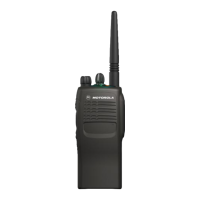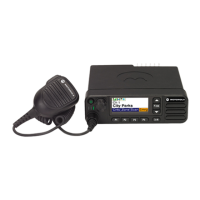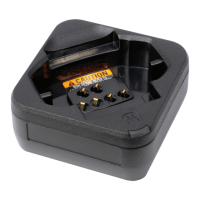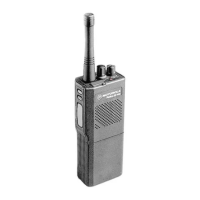54
brief description for each parameter. Refer to the
RSS manual for general instructions in the use of
RSS.
2. Set Secure-Equipped Field
The radio must be reprogrammed to utilize the
secure module. At the RSS main menu, press F4
for the CHANGE/CREATE/VIEW menu. Press F3
for the Radio Wide Buttons, Switches, Display,
Scan, Phone screen. Press F2 for Radio Wide
Options screen. Here, press tab to reach the
Secure Equipped field. Press up/down arrow keys
to select YES.
3. Set XL IC Present Field
If the secure module has an XL IC (the Range
Extension or -XL option), the radio must be repro-
grammed to show that this IC is present. While still
in the Radio Wide Options screen, press F6 to see
Secure Options. Press Tab until the XL IC Present
field is highlighted. Press up/down arrow keys to
select YES. If the secure module does not have an
XL IC, set the XL IC Present field to NO.
4. Enable Secure On Desired Channels
To actually use the secure option, Secure must be
enabled on the channels for which it is desired. A
channel can be strapped to secure-only, or clear-
only, or secure/clear-selectable.
For conventional channels, proceed as follows:
Press F4 at the Main Menu to see the
CHANGE/CREATE/VIEW menu. Press F6 to see
Conventional Systems, Personalities, MDC,
Options. Press F3 to see Conventional Personali-
ties, Options. Press F6 to see the SECURE
OPTIONS screen. Press Tab to select the
Secure/Clear Strapping field.
For trunking channels, proceed as follows: Press
F4 at the Main Menu to see the CHANGE/CRE-
ATE/VIEW menu. Press F4 to see Trunking
Systems, Personalities, Call Lists, Options screen.
Press F4 to see Trunking Personalities: Talk
Groups, Emergency Options, etc. Press Tab to
select the Strapping field. An Announcement Group
must be specified for the Strapping parameter to
appear. This selects the Announcement Group
Strapping. Press F7 to select Talk Groups. Press
Tab to select the strapping of each Talk Group.
5. Other Secure Options
There are other secure options that can be
changed on a per-channel basis, such as: Proper
Code Detection, Transmit XL, or CFB. For conven-
tional channels, these options are found on the
same screen as Secure/Clear Strapping
(F4/F6/F3/F6). These options are XL Transmit,
Scan Holdoff Strapping, RX Modulation, and Proper
Code Detect. For trunking channels, the only
selectable option is Proper Code Detect. This can
be found by going to the MORE OPTIONS screen
(F9) from the screen that was used to select
secure/clear Strapping for trunking channels.
D. Secure Retrofit Tuning
After installing a secure-retrofit board into a radio,
the secure TX deviation and the secure RX discrimina-
tor level must be tuned. Follow the procedure outlined
in section III of this publication for the tuning of these
two secure-related alignments.
The TX deviation balance (compensation) does not
need to be performed as part of the secure retrofit pro-
cedure. Use the transmit deviation balance
(compensation) procedure as outlined in this appendix,
section III paragraph B, only when a complete radio
alignment is being performed with a secure board
installed.
VI. SECURE ALIGNMENT PROCEDURE
A. General
For optimum radio performance, the secure trans-
mit deviation and the receive discriminator level must
be set. Refer to SECTION V, RADIO ALIGNMENT
PROCEDURE, for a description of the radio alignment
test setup, an RSS service menu overview, and for gen-
eral radio tuning procedures. All normal radio tuning
should be performed in the proper sequence before
proceeding with secure tuning.
Note that the transmit deviation balance (compen-
sation) tuning must be performed differently if a secure
board is installed in the radio. Follow the procedure
changes outlined below when tuning transmit deviation
balance, and complete the normal tuning. Then pro-
ceed with the additional tuning for secure TX deviation
and secure RX discriminator level tuning.
B. Transmit Deviation Balance (Compensation)
When tuning with a secure board installed, the cou-
pling capacitor inside the RKN4035A Test Cable will
cause rolloff of the low port modulation. To fix this, the
cable should be dc coupled ("VOL" position) and an
external coupling capacitor (1.3µF or larger) must be
placed in series with the signal source input to the
AC/DC MTR.
Follow the Transmit Deviation Balance (Compensa-
tion) procedure outlined in section V paragraph G,
except change step 3 as follows:
3. Set the RTX4005B Test Box meter selector switch
to the "VOL" position, and connect the signal
source to the AC/DC MTR port thru a 1.3µF capaci-
tor. Inject an 80 Hz tone at 100mVrms thru this
capacitor. Keep the ac voltmeter in parallel to the
AC/DC MTR input to ensure the proper input signal
level.

